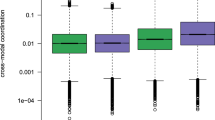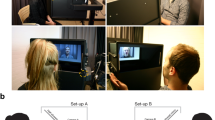Abstract
Short unstructured social interactions between a volunteer interviewer, an adult with autism of Asperger type, and a control subject with a schizoid personality disorder were video-recorded. Asperger subjects tended to look less at the other person, to make more self-stimulatory gestures, and to look at the interviewer significantly less than normal subjects, and substantially less than schizoid subjects, during the periods when the interviewer was vocalizing although there were no such differences when the interviewer was listening. We suggest that the gaze avoidance of autism may in actuality be a lack of expected gaze (e.g., gaze when the other person is talking) rather than an absolute avoidance, and suggest that a lifelong absence of gaze response to social cues including speech could explain a number of the developmental features of autism including lack of joint attention with others, lack of understanding and affective response to others, and poor discrimination of facial expressions.
Similar content being viewed by others
References
Adamson, L., & Bakeman, R. (1982). Affectivity and reference: Concepts, methods, and techniques in the study of communication development of 6- to 18-month-old infants. In T. Field & A. Fogel (Eds.),Emotion and early interaction (pp. 213–236). Hillsdale, NJ: Erlbaum.
Allison, P. D., & Liker, J. K. (1982). Analyzing categorical sequential data on dyadic interaction: a comment on Gottman.Psychological Bulletin, 91, 393–403.
American Psychiatric Association. (1987).Diagnostic and statistical manual of mental disorders (3rd. ed., rev.). Washington, DC: Author.
Argyle, M. (1988).Bodily communication (2nd. ed.). London: Methuen.
Attwood, A., Frith, U., & Hermelin, B. (1988). The understanding and use of interpersonal gestures by autistic and Down's syndrome children.Journal of Autism and Developmental Disorders, 18, 241–258.
Austin, A., & Perry, J. (1983). Analysis of adult-neonate synchrony during speech and nonspeech.Perceptual and Motor Skills, 57, 455–459.
Bakeman, R., & Gottman, J. M. (1987).Observing interaction: An introduction to sequential analysis. Cambridge: Cambridge University Press.
Churchill, D. W., & Bryson, C. (1972). Looking and approach behavior of psychotic and normal children as a function of adult attention or preoccupation.Comprehensive Psychiatry, 13, 171–177.
Ciesielski, K. T., Courchesne, E., & Elmasian, R. (1990). Effects of focussed selective attention tasks on event-related potentials in autistic and normal individuals.Electroencephalography and Clinical Neurophysiology, 75, 207–220.
Cohen, I. G., Vietze, P. M., Sudhalter, V., Jenkins, E. C., & Brown, W. T. (1989). Parent-child dyadic gaze patterns in fragile X males and in non-fragile X males with autistic disorder.Journal of Child Psychology and Psychiatry, 30, 845–857.
Cohen, J. (1960). A coefficient of agreement for nominal scales.Educational and Psychological Measurement, 20, 37–46.
Condon, W. S., & Ogston, W. D. (1966). Sound film analysis of normal and pathological behavior patterns.Journal of Nervous and Mental Disease, 142, 338–346.
Exline, R., & Fehr, B. (1982). The assessment of gaze and mutual gaze. In K. Scherer & P. Ekman (Eds.),Handbook of methods of nonverbal behaviour research. Cambridge: Cambridge University Press.
Frith, U. (1989).Autism: explaining the enigma. Oxford: Basil Blackwell.
Frith, U., & Baron-Cohen, S. (1987). Perception in autistic children. In D. Cohen, A. Donnellan, & R. Paul (Eds.),Handbook of autism and pervasive developmental disorders. New York: Wiley.
Hedge, B., Everitt, B., & Erith, C. (1978). The role of gaze in dialogue.Acta Psychologia, 42, 453–475.
Hermelin, B., & O'Connor, N. (1970).Psychological experiments with autistic children. Oxford: Pergamon Press.
Huti, C., & Ounsted, C. (1966). The biological significance of gaze aversion with particular reference to the syndrome of infantile autism.Behavioral Science, 11, 346–356.
Kasari, C., Sigman, M., Mundy, P., & Yirmiya, N. (1990). Affective sharing in the context of joint attention interactions of normal, autistic, and mentally retarded children.Journal of Autism and Developmental Disorders, 20, 87–100.
Martineau, J., Barthélémy, C., Roux, S., Garreau, B., & Lelord, G. (1989). Electrophysiological effects of fenfluramine or combined vitamin B6 and magnesium on children with autistic behaviour.Developmental Medicine and Child Neurology, 31, 728–736.
Maxwell, K. (1970).Basic statistics in behavioural research Harmondsworth, Middlesex: Penguin.
McDowall, J. (1978). Interactional synchrony: A reappraisal.Journal of Personality and Social Psychology, 36, 963–975.
Morton, J., & Johnson, M. (1991). CONSPEC and CONLERN: A two-process theory of infant face recognition.Psychological Review, 98, 164–181.
Mundy, P., Sigman, M., & Kasari, C. (1990). A longitudinal study of joint attention and language development in autistic children.Journal of Autism and Developmental Disorders, 20, 115–128.
Mundy, P., Sigman, M., Ungerer, J., & Sherman, T. (1986). Defining the social deficits of autism: The contribution of non-verbal communication measures.Journal of Child Psychology and Psychiatry, 27, 657–669.
O'Connor, N., & Hermelin, B. (1967). The selective visual attention of psychotic children.Journal of Child Psychology and Psychiatry, 8, 167–179.
Raven, J. C. (1956).Standard Progressive Matrices (revision). London: H. K. Lewis.
Richer, J. (1976). The social-avoidance behaviour of autistic children.Animal Behaviour, 24, 898–906.
Rowen, J. C. (1958).Mill Hill Vocabulary Scales. London: H. K. Lewis.
Rutter, M. (1978). Diagnosis and definition of childhood autism.Journal of Autism and Childhood Schizophrenia, 8, 139–161.
Seigel, S. (1956).Non-parametric statistics for the behavioral sciences. Tokyo: McGraw Hill Kogakusha.
Sigman, M., Mundy, P., Sherman, T., & Ungerer, J. (1986). Social interactions of autistic, mentally retarded and normal children and their caregivers.Journal of Child Psychology and Psychiatry, 27, 647–656.
Stern, D. (1971). A micro-analysis of mother-infant interaction.Journal of the American Academy of Child and Adolescent Psychiatry, 10, 507–517.
Tantam, D. (1988a). Annotation: Asperger's syndrome.Journal of Child Psychology and Psychiatry, 29, 836–840.
Tantam, D. (1988b). Lifelong eccentricity and social isolation: I. Psychiatric, social, and forensic aspects.British Journal of Psychiatry, 153, 777–782.
Tantam, D. (1988c). Lifelong eccentricity and social isolation. II. Asperger's syndrome or schizoid personality disorder?British Journal of Psychiatry, 153, 783–791.
Tantam, D. (1991). Characterizing the fundamental social handicap of autism.Acta Paedopsychiatrica, 55, 83–91.
Tantam, D., Stirling, S., Monaghan, L. & Nicholson, H. (1989). Autistic children's ability to interpret faces: a research note.Journal of Child Psychology and Psychiatry, 30, 623–630.
Trevarthen, C. (1979). Communication and cooperation in early infancy: A description of primary intersubjectivity. In M. Bullowa (Ed.), Before speech: The beginning of interpersonal communication (pp. 321–347). Cambridge: Cambridge University Press.
Van Engeland, H., Bodnar, F. A., & Bolhuis, G. (1985). Some qualitative aspects of the social behavior of autistic children: An ethological approach.Journal of Child Psychology, Psychiatry and Allied Disciplines, 26, 879–893.
Vine, I. (1971). Judgement of direction of gaze: an interpretation of discrepant results.British Journal of Social and Clinical Psychology, 10, 320–331.
Wechsler, D. (1955).Wechsler Intelligence Scale for Children—Revised. New York: Psychological Corporation.
Wing, L., & Gould, J. (1979). Severe impairments of social interaction and associated abnormalities in children: epidemiology and classification.Journal of Autism and Developmental Disorders, 9, 11–29.
Author information
Authors and Affiliations
Additional information
We are grateful to the many people who have helped and sustained us during the long gestation of this study, especially Uta Frith who has taught so effectively by example. Without the considerable assistance of our patients with Asperger syndrome, their families, and the professionals involved with them, the study would not have been possible and we take this opportunity to thank them. We are also grateful for the detailed and helpful comments of the anonymous reviewers appointed by the Journal. The study has been partly supported by a MRC Research Fellowship awarded to Digby Tantam, and by a research associateship awarded to David Holmes by Manchester Polytechnic.
Rights and permissions
About this article
Cite this article
Tantam, D., Holmes, D. & Cordess, C. Nonverbal expression in autism of Asperger type. J Autism Dev Disord 23, 111–133 (1993). https://doi.org/10.1007/BF01066422
Issue Date:
DOI: https://doi.org/10.1007/BF01066422




